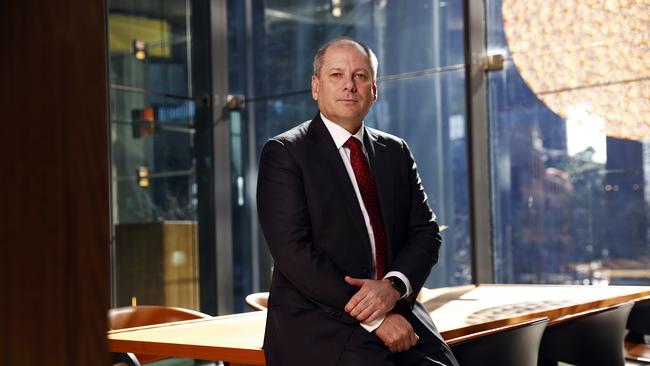APRA gives Westpac $500m capital reprieve as bank lifts its compliance game
The prudential regulator has halved the additional capital imposed on Westpac for compliance and governance failures, citing improvements in the bank’s culture and risk management.

Business
Don't miss out on the headlines from Business. Followed categories will be added to My News.
The prudential regulator has cut the additional capital imposed on Westpac for compliance and governance failures in half to $500m, citing improvements in the bank’s culture, risk management and governance.
The Australian Prudential Regulation Authority on Friday said the $1bn capital overlay forced on Westpac in tranches through 2019, would be reduced to $500m in recognition of the “progress and improvements” delivered by the bank under its rectification program, CORE.
The change is effective immediately.
The decision marks an important milestone for Westpac which emerged at the centre of a financial crimes scandal in late 2019, but the bank still has to satisfy the regulator the changes are sustainable to have the remaining capital charge removed.
APRA’s move means just ANZ and Westpac are left with additional capital overlays slapped on the big banks during the fallout from the Hayne royal commission.
National Australia Bank had its $500m capital add on removed in March when APRA was satisfied it had completed remediation and addressed governance issues.
The prudential regulator freed Commonwealth Bank of a remaining $500m capital overlay in 2022, saying it was satisfied the lender had addressed a spate of weaknesses across governance, culture and accountability. CBA had a capital overlay of $1bn during the height of its anti-money laundering issues and other compliance failures.
Westpac’s additional capital imposition was increased to $1bn by APRA in December 2019, when it was embroiled in a scandal that involved breaches of anti-money laundering provisions.
The bank eventually paid a record $1.3bn fine to financial crimes regulator Austrac to settle the matter and entered into an enforceable undertaking with APRA in late 2020 as it worked to fix weaknesses in its systems, culture and governance.
That also involved appointing an independent reviewer to oversee the program of work.
Westpac’s shares were 1.4 per cent lower to $28.08 at 11:30am AEST on Friday, as the S&P/ASX200 fell 1.22 per cent.
E&P analyst Azib Khan said the removal of half of Westpac’s capital add-on had come “a little earlier” than he had expected.
“Our forecasts have allowed for half the add-on to be removed in 1H25 (the first half of 2025) and the remainder to be removed in 1H26,” he said.
“A key reason why Westpac is our preferred major bank is because of our view that it has largely dealt with its obligations under the APRA enforceable undertaking...
Westpac now has an opportunity to shift its focus away from the APRA EU to improving operational performance.”
Mr Khan anticipates the halving of Westpac’s capital overlay will see the bank boost its capital return initiatives for shareholders.
“ In addition to the $2.5bn on-market buyback currently underway, we expect capital management of $2.25bn by the end of financial year 2026,” he said.
In response to APRA’s decision on Friday, Westpac chief executive Peter King said: “Westpac is now a simpler, stronger bank with substantially improved risk governance. We have moved into the transition period, which involves sustainably embedding the uplift in risk management practices.”
The bank said the reduction in the capital overlay would see its common equity tier one capital ratio rise by about 18 basis points, as risk-weighted assets declined to $6.25bn.
Westpac’s drive to fix its systems and risk management failings was centred on its Customer Outcomes and Risk Excellence (CORE) program which reflected several streams to change and embed the bank’s processes and culture.
The bank still has some work to do, however, to have the remaining $500m capital overlay removed by APRA.
“The remaining $500m capital add-on will remain in place until Westpac completes its transition work and APRA undertakes further validation work to assess the sustainability of improvements made in risk governance, culture and accountability practices and outcomes,” the regulator said.
Many of the banks are, though, still in the spotlight for questionable behaviour.
The corporate regulator this week released a report showing CBA, Westpac, Bendigo and Adelaide Bank, and ANZ charged 150,000 Australians - many of whom were relying on welfare payments - for high fee accounts when they were eligible for low charge equivalents. The Australian Securities and Investments Commission said as a result of its broader findings relating to vulnerable and low-income customers banks were refunding $28m to customers.
Originally published as APRA gives Westpac $500m capital reprieve as bank lifts its compliance game





